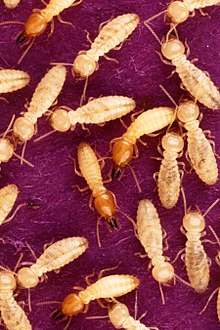What does termitarium mean?
Definitions for termitarium
ˌtɜr mɪˈtɛər i əm; -ˈtɛər i əter·mi·tar·i·um
This dictionary definitions page includes all the possible meanings, example usage and translations of the word termitarium.
Did you actually mean trinitarian or trematode worm?
Wiktionary
termitariumnoun
A termite colony.
Wikipedia
termitarium
Termites are a group of detritophagous eusocial insects which consume a wide variety of decaying plant material, generally in the form of wood, leaf litter, and soil humus. They are easily identified by the typically soft-bodied and unpigmented worker caste for which they have been colloquially termed "white ants"; however, they are not ants, to which they are distantly related. About 2,972 extant species are currently described, 2,105 of which are members of the family Termitidae. Termites comprise the infraorder Isoptera, or alternatively the epifamily Termitoidae, within the order Blattodea (along with cockroaches). Termites were once classified in a separate order from cockroaches, but recent phylogenetic studies indicate that they evolved from cockroaches, as they are deeply nested within the group, and the sister group to wood eating cockroaches of the genus Cryptocercus. Previous estimates suggested the divergence took place during the Jurassic or Triassic. More recent estimates suggest that they have an origin during the Late Jurassic, with the first fossil records in the Early Cretaceous. Similar to ants and some bees and wasps from the separate order Hymenoptera, most termites have an analogous 'worker' and 'soldier' caste system consisting of mostly sterile individuals which are morphologically and behaviorally distinct. Unlike ants, most colonies begin from reproductively mature individuals called "kings" and "queens" which form monogamous pairs. Also unlike ants, which undergo a complete metamorphosis, termites undergo an incomplete metamorphosis that proceeds through egg, nymph, and adult stages. Termite colonies are commonly described as superorganisms due to the collective behaviors of the individuals which form a self-governing entity: the colony itself. Their colonies range in size from a few hundred individuals to enormous societies with several million individuals. Most species are rarely seen, having a cryptic life-history where they remain hidden within the galleries and tunnels of their nests for most of their lives. Termites' success as a group has led to them colonizing almost every global landmass except Antarctica, with the highest diversity occurring in the tropics where they are estimated to constitute 10% of the biomass, particularly in Africa which has the richest diversity with more than 1000 described species. They are important decomposers of decaying plant matter in the subtropical and tropical regions of the world, and their recycling of wood and plant matter is of considerable ecological importance. Many species are ecosystem engineers capable of altering soil characteristics such as hydrology, decomposition, nutrient cycling, vegetative growth, and consequently surrounding biodiversity through the large mounds constructed by certain species.Termites have several impacts on humans. They are a delicacy in the diet of some human cultures such as the Makiritare in the Alto Orinoco province of Venezuela, where they are commonly used as a spice. They are also used in traditional medicinal treatments of various diseases and ailments, such as influenza, asthma, bronchitis, etc. Termites are most famous for being structural pests, however, the vast majority of termite species are innocuous, with the regional numbers of economically significant species being: North America, 9; Australia, 16; Indian subcontinent, 26; tropical Africa, 24; Central America and the West Indies, 17. Of known pest species, 28 of the most invasive and structurally damaging belong to the genus Coptotermes. The distribution of most known pest species is expected to increase overtime as a consequence of climate change.
Entomology
Termitarium
a nest, natural or artificial, or a colony of Termites.
Numerology
Chaldean Numerology
The numerical value of termitarium in Chaldean Numerology is: 7
Pythagorean Numerology
The numerical value of termitarium in Pythagorean Numerology is: 3
Translations for termitarium
From our Multilingual Translation Dictionary
Get even more translations for termitarium »
Translation
Find a translation for the termitarium definition in other languages:
Select another language:
- - Select -
- 简体中文 (Chinese - Simplified)
- 繁體中文 (Chinese - Traditional)
- Español (Spanish)
- Esperanto (Esperanto)
- 日本語 (Japanese)
- Português (Portuguese)
- Deutsch (German)
- العربية (Arabic)
- Français (French)
- Русский (Russian)
- ಕನ್ನಡ (Kannada)
- 한국어 (Korean)
- עברית (Hebrew)
- Gaeilge (Irish)
- Українська (Ukrainian)
- اردو (Urdu)
- Magyar (Hungarian)
- मानक हिन्दी (Hindi)
- Indonesia (Indonesian)
- Italiano (Italian)
- தமிழ் (Tamil)
- Türkçe (Turkish)
- తెలుగు (Telugu)
- ภาษาไทย (Thai)
- Tiếng Việt (Vietnamese)
- Čeština (Czech)
- Polski (Polish)
- Bahasa Indonesia (Indonesian)
- Românește (Romanian)
- Nederlands (Dutch)
- Ελληνικά (Greek)
- Latinum (Latin)
- Svenska (Swedish)
- Dansk (Danish)
- Suomi (Finnish)
- فارسی (Persian)
- ייִדיש (Yiddish)
- հայերեն (Armenian)
- Norsk (Norwegian)
- English (English)
Word of the Day
Would you like us to send you a FREE new word definition delivered to your inbox daily?
Citation
Use the citation below to add this definition to your bibliography:
Style:MLAChicagoAPA
"termitarium." Definitions.net. STANDS4 LLC, 2025. Web. 12 Mar. 2025. <https://www.definitions.net/definition/termitarium>.







Discuss these termitarium definitions with the community:
Report Comment
We're doing our best to make sure our content is useful, accurate and safe.
If by any chance you spot an inappropriate comment while navigating through our website please use this form to let us know, and we'll take care of it shortly.
Attachment
You need to be logged in to favorite.
Log In